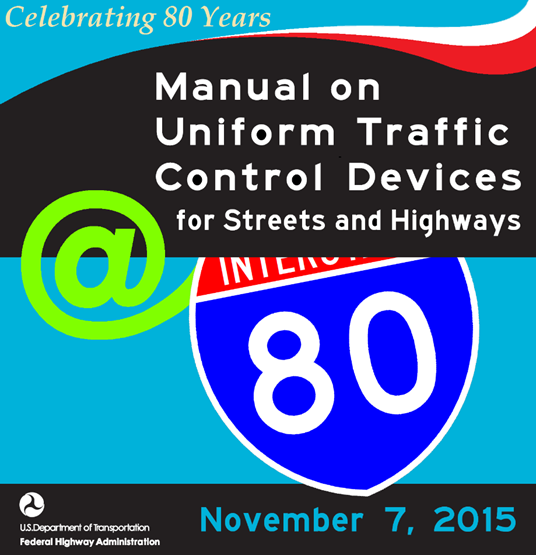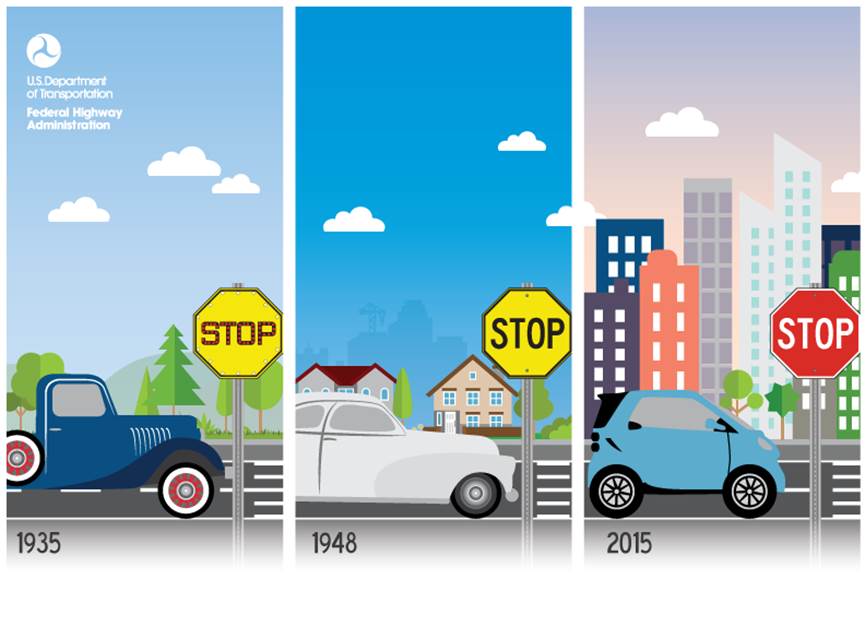|
|
 |
Happy Birthday to the MUTCD!The MUTCD Turns 80!The following is an archived posting from the official blog of the USDOT on the eve of the 80th birthday of the MUTCD. Happy Birthday to the MUTCD!November 6, 2015 The Manual on Uniform Traffic Control Devices for Streets and Highways (MUTCD) turns 80 tomorrow, and this octogenarian is still going strong. The secret of its vitality? The MUTCD remains active by helping the rest of us get to where we need to go safely and efficiently. 
The TCD in MUTCD --"traffic control devices"-- refers to all of the signs, signals, pavement markings, and other features that communicate with drivers all along America's road system. From city streets to interstate highways, and covering a variety of shared-use facilities, this system moves the U.S. economy forward and gives us all a key freedom that has become part of the American ethos: mobility. The MUTCD doesn't simply promote the mobility of goods and services; its guidelines and standardization help drivers, passengers, motorcyclists, bicyclists, and pedestrians get where they're going and get there safely--no matter what part of the country they're in. From the first road signs in ancient Rome--literal milestones that ticked-off the distance to the next city--traffic control devices have helped direct travelers on their journeys for centuries. The evolution of these road signs provides a fascinating insight not only into the evolution of traffic control devices, but also to the pace of economic and social development around them. The arrival of the automobile early in the last century revolutionized travel, but the explosion in automobile traffic also created a need for the road signs and traffic signals that now populate our streets and highways. The new ability to travel rapidly from State to State, however, meant that some degree of uniformity was needed so drivers from Pennsylvania would be able to understand traffic signs and signals in Colorado. That's where the MUTCD comes in. From day one, the MUTCD has been a faithful, albeit silent, companion to road users. 1935 was in many ways a very good year, putting the MUTCD in good company. In 1935, the Gallup Poll was introduced. A DuPont scientist produced a completely synthetic fiber called "nylon." The musical genre known as "Swing" was born, thanks to Benny Goodman. The average cost of a new house was $3,450, average annual wages were $1,600, and a gallon of gas cost 10 cents. And the MUTCD arrived on the scene, just in time to help America travel better, safer, and more efficiently.

Although the MUTCD has been the national standard for traffic control devices for eight decades, it is by no means stale or outdated. On the contrary, it is continuously being updated to reflect the ever- changing needs of the people and the equally dynamic advances in technology. Ten editions have been published since 1935, which, by any measure, is a lot of makeovers. And as our traffic control devices have evolved, the MUTCD has kept pace to help 20th- and 21st- Century travelers move safely to their destinations. The principles that have guided the development and evolution of the MUTCD have remained the same: to be effective, traffic control devices must fulfill an operational need; convey a clear meaning so a sign is universally understood; and be located in a consistent place that can be easily recognized and reacted to. The MUTCD's first edition, published by the American Association of State Highway Officials --known today as the American Association of State Highway and Transportation Officials or AASHTO-- classified signs as regulatory, warning; or guide. It also introduced America to the importance of pavement markings and adopted rules for the three-color traffic signal, one of the most underrated safety advances in roadway history. And, it offered a degree of local flexibility; although the manual is the law governing all traffic control devices, it does includes three levels of mandate --"shall," "should," and "may"-- which affords local transportation authorities a high degree of leeway to accommodate differing roadway environments. Over time, the Manual has showed cities and towns the way to go when it came to traffic control devices used during various conditions, such as blackout conditions in wartime in 1942. In 1954, the MUTCD ushered in the modern "STOP" sign as we now know it: white letters on a red octagonal background, which replaced a similar version with a yellow background. The manual set the bar for a variety of construction and maintenance operations in 1961; placed a new emphasis on signs near schools in 1971; and updated traffic control devices for highway-rail grade crossings and bicycle facilities in 1978. Of course, any uniform compendium of devices designed to address, alert, and inform travelers across a vast nation in an era of rapidly evolving technologies is bound to require revision. This is why we at the Federal Highway Administration continue to work with our stakeholders to always stay one step, one street, one sign, and one signal ahead of potential pitfalls and mobility concerns. In the years ahead, this will mean developing and refining messages uniformly for those who need to navigate newer roadway features such as managed lanes, separated bike lanes, and other environments. As songwriter Bob Dylan famously sang, "The times, they are a-changing," and our road signs and other traffic devices will change with the times. As will the MUTCD. Since before there were baby boomers, the MUTCD has been a mobility boomer, keeping Americans safe and keeping America moving forward. So, happy birthday, MUTCD, and many thanks to all of the transportation engineers who have made the MUTCD's first 80 years so successful. |
|||
|
United States Department of Transportation - Federal Highway Administration |
||